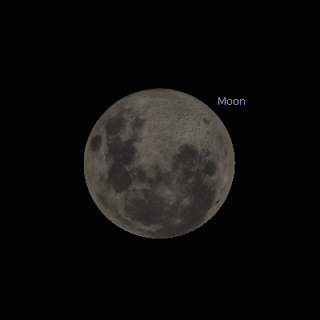Wednesday, January 13, 2021
2021: From "Super" Moon to "Mini" Moon and back, a year of full Moons
| Full Moon January 29, 0:500 AEST | Full Moon February 27 18:00. Minimum libration -30h | Full Moon March 29 05:00 AEST, Perigee +35h March 10. |
| Full Moon April 27 14:00, perigee April 28 + 11h | Full Moon May 26 21:00, perigee May 26 -9h Total Lunar Eclipse. 21:10 | Full Moon June 25 05:00, perigee June 23 -24h |
| Full Moon July 24 13:00. | Full Moon August 22 22:00. Maximum Libration +24 h | Full Moon September 21 10:00. |
| Full Moon October 21 01:00, | Full Moon November 19 19:00, apogee +41h. Twilight Partial Lunar eclipse | Full Moon December 19 15:00 Moon at apogee 18th -26h |
A year of full Moons showing the variation in size as the moons move from perigee to apogee. All the moons are shown on the day and time (AEST) they are full (unless they are below the horizon, in which case the size at astronomical twilight is shown), and although this is not the optimal time for size comparisons, you can clearly see the size difference over the year (compare April 27 to November 19) the original scale for all is 2 degrees of field of view cropped down to about two lunar diameters width). Although the field rotation of the Moon makes it less clear, you can also see the effect of libration.
In 2021 we have two good Perigee Moon is a row (April 27, May 26). One of which is a total Lunar Eclipse Moon (May 26). However, as you can see the differences are subtle, and it requires a keen eye and good memory to distinguish a perigee "super" Moon from more ordinary moons, the best contrast is with the apogee "mini" moons of November 19/December 19).
That doesn't mean you shouldn't try though. Daniel Fischer has been able to see the difference, you can read his account and viewing tips here
http://earthsky.org/space/can-you-discern-supermoons-large-size-with-the-eye-an-observer-says-yes
Photographing them can be more rewarding. You can see images of perigee Moon and apogee Moon pairs from 21 Jan 2019 here and 10 August 2014 here.Tips for photographing them are here.
Labels: apogee, Blue Moon, Moon, perigee, public outreach, unaided eye, Yearly Moons















 Click to read about or order
Click to read about or order Click to read about or order
Click to read about or order Click to read about or order
Click to read about or order Click to read about or order
Click to read about or order




